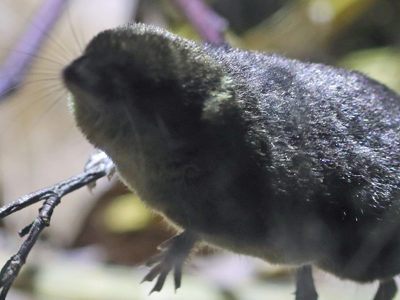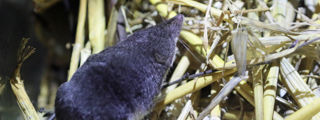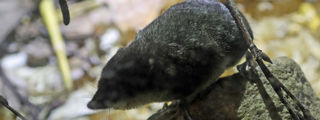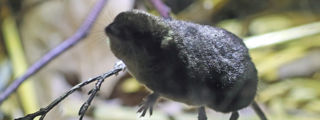
Eurasian Water Shrew
Neomys fodiens
The Eurasian Water Shrew is the largest UK shrew, weighing between 12g and 18g. Their appearance is typical of a shrew, with a long pointy snout, small eyes and ears. They have dense short fur, with a velvety appearance, ranging in colour from grey to black. Their underside is normally white with a clear separation along their side of the upper and lower surface colours, although the black melanistic forms occur. Some have white tufts of hair on their ears. A distinguishing feature are the the fringes stiff white hairs on the underside of the tail.

Habitat
Wetland habitats (both fresh and saltwater), including damp grasslands, rivers, lakes, bogs, marshes, sea shores and intertidal wetlands. Fast flowing and unpolluted water sources are the most preferred.

Behaviour
Nocturnal, particularly active just before dawn. Solitary and both sexes hold territories until the breeding season when males visit female territories to mate. Unlike most small mammals in the UK, water shrews don’t hibernate in their burrows but remain active all year round.
They hunt for invertebrates both on land and in the water, diving up to 70cm. The stiff hairs on the underside of their feet and tail aid them in swimming, acting as a rudder.

UK Status
Found throughout UK, with a patchy distribution in northern Scotland. Larger islands such as the Isle of Wight, Anglesey, Skye and Mull all have populations, but are not present on most other UK islands. Not a huge deal known about the state of water shrew populations throughout the UK.
Distribution
Large European range the extent of which stretches from the UK in the west, to Mongolia in the east. It is widespread throughout its European range.
Diet
Aquatic invertebrates such as shrimps, crayfish, water skaters, and caddisfly larvae. Occasionally larger prey such as small fish and amphibians are also eaten.
Threats
Habitat loss and degradation, particularly water pollution and drainage, is thought to have a big impact on their numbers throughout their range.
Family facts
- Their saliva contains venom used to subdue their invertebrate prey. To humans, a bite just results in an irritable rash. However, the venom compound itself once isolated and created in a lab has a lot of positive medical potential.
- Their fur is thick and water repellent, protecting them from cold, wet conditions.

